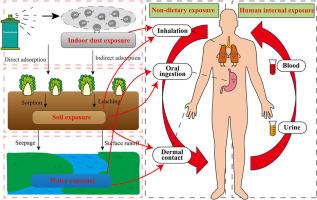A systematic review of non-dietary human risks of neonicotinoids in China: environmental concentrations, human exposure and risk assessment
IF 7.3
2区 环境科学与生态学
Q1 ENVIRONMENTAL SCIENCES
引用次数: 0
Abstract
Neonicotinoids (NEOs) are extensively used in China and become a national concern due to their prevalence in the environment and human bodies. However, the non-dietary exposure to NEOs and their health risks to Chinese population remained unclear. This review compiled a comprehensive national dataset, comprising 39 studies on environmental concentrations across surface water, soil and indoor dust, as well as 20 studies on human internal exposure. Our analysis revealed that six NEOs, namely imidacloprid, acetamiprid, thiacloprid, dinotefuran, thiamethoxam and clothianidin, were widely distributed across all environmental media with distinct regional characteristics. Imidacloprid and acetamiprid exhibited relatively higher concentrations, while thiacloprid showed the lowest concentrations. Subsequently, people’s non-dietary exposure to NEOs based on NEO environmental concentrations was investigated, considering routes including oral intake, dermal contact and inhalation. Surface water was the primary source of non-dietary exposure, accounting for 65.1% to 98.2%, followed by indoor dust and soil. Regionally, Hainan, Zhejiang, Hebei exhibited relatively high non-dietary chronic daily intake values. Additionally, NEO concentrations in human blood and urine were analyzed across different populations, and total daily intakes of NEOs were estimated accordingly. Non-dietary exposure to NEOs contributed only 0.2% to 7.6% of the total NEO exposure, with children experiencing higher proportions. Although the carcinogenic and non-carcinogenic risks from non-dietary exposure to NEOs were relatively low, children faced significantly higher risks. Future studies should target on NEO management and control in aquatic environments, the combined health effects of NEOs and other contaminants, and strategies for protecting children from NEO exposure.

中国新烟碱类物质对人类非饮食风险的系统回顾:环境浓度、人类暴露和风险评估
新烟碱类化合物在中国被广泛使用,因其在环境和人体中的普遍存在而成为国家关注的问题。然而,非饮食接触neo及其对中国人群的健康风险尚不清楚。这篇综述汇编了一个全面的国家数据集,包括39项关于地表水、土壤和室内灰尘的环境浓度的研究,以及20项关于人体内部暴露的研究。结果表明,吡虫啉、啶虫啉、噻虫啉、呋虫胺、噻虫嗪和噻虫胺6种neo广泛分布于所有环境介质中,具有明显的区域特征。吡虫啉和啶虫啉的浓度较高,噻虫啉的浓度最低。随后,研究人员根据NEO环境浓度调查了人们对NEO的非饮食暴露,包括口服摄入、皮肤接触和吸入途径。地表水是主要的非膳食暴露源,占65.1% ~ 98.2%,其次是室内灰尘和土壤。从区域上看,海南、浙江、河北的非膳食性慢性日摄入量较高。此外,还分析了不同人群血液和尿液中的NEO浓度,并据此估算了NEO的每日总摄入量。非饮食接触近地天体仅占近地天体接触总量的0.2%至7.6%,其中儿童的比例更高。虽然非饮食接触neo的致癌和非致癌风险相对较低,但儿童面临的风险明显更高。未来的研究应着眼于水生环境中的近地天体管理和控制、近地天体和其他污染物对健康的综合影响,以及保护儿童免受近地天体接触的战略。
本文章由计算机程序翻译,如有差异,请以英文原文为准。
求助全文
约1分钟内获得全文
求助全文
来源期刊

Environmental Pollution
环境科学-环境科学
CiteScore
16.00
自引率
6.70%
发文量
2082
审稿时长
2.9 months
期刊介绍:
Environmental Pollution is an international peer-reviewed journal that publishes high-quality research papers and review articles covering all aspects of environmental pollution and its impacts on ecosystems and human health.
Subject areas include, but are not limited to:
• Sources and occurrences of pollutants that are clearly defined and measured in environmental compartments, food and food-related items, and human bodies;
• Interlinks between contaminant exposure and biological, ecological, and human health effects, including those of climate change;
• Contaminants of emerging concerns (including but not limited to antibiotic resistant microorganisms or genes, microplastics/nanoplastics, electronic wastes, light, and noise) and/or their biological, ecological, or human health effects;
• Laboratory and field studies on the remediation/mitigation of environmental pollution via new techniques and with clear links to biological, ecological, or human health effects;
• Modeling of pollution processes, patterns, or trends that is of clear environmental and/or human health interest;
• New techniques that measure and examine environmental occurrences, transport, behavior, and effects of pollutants within the environment or the laboratory, provided that they can be clearly used to address problems within regional or global environmental compartments.
 求助内容:
求助内容: 应助结果提醒方式:
应助结果提醒方式:


